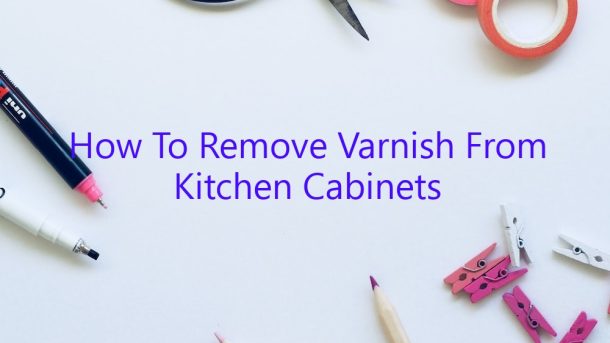Removing varnish from kitchen cabinets can be a daunting task, but with the right tools and a little bit of patience, it can be done. Here are a few tips to help make the process a little bit easier:
-To remove the varnish, you will need to use a stripper. There are a few different types of strippers available, so be sure to choose one that is specifically designed for varnish.
-Be sure to read the instructions carefully before using the stripper. It is important to follow the instructions to the letter to avoid any accidents.
-Wear gloves and goggles when using the stripper, and be sure to keep it out of reach of children and pets.
-Apply the stripper to the cabinet in a thin, even layer.
-Wait for the stripper to dry completely before removing it with a scraper.
-Be careful not to damage the underlying wood while scraping the varnish off.
-Once all the varnish has been removed, clean the cabinets with a mild detergent and water.
– allow the cabinets to dry completely before applying a new coat of varnish.
Contents
What will dissolve varnish?
What will dissolve varnish?
The answer to this question depends on the type of varnish that is being dissolved. There are many different types of varnish, some of which are more difficult to dissolve than others.
One common type of varnish is shellac. Shellac is a natural resin that is derived from the lac beetle. It is a common finish for woodworking projects, and it can be dissolved with alcohol.
Another type of varnish that can be dissolved with alcohol is lacquer. Lacquer is a synthetic resin that is usually applied with a spray gun. It is a common finish for furniture and other woodworking projects. Lacquer can also be dissolved with ammonia.
There are also many types of synthetic varnishes that can be dissolved with solvents such as acetone or xylene. These solvents can be harmful if they are inhaled, so it is important to use them in a well-ventilated area.
It is important to note that not all types of varnish can be dissolved with alcohol or ammonia. Some types of varnish are made with polyurethane, and these varnishes cannot be dissolved with alcohol or ammonia.
How do you remove varnish without sanding?
When it comes to refinishing hardwood floors, many people think that the only way to achieve a smooth finish is to sand the surface down to the bare wood. However, there are other ways to remove the finish from a floor without sanding.
One way to remove varnish without sanding is to use a chemical stripper. Chemical strippers are available at most hardware stores, and they come in both liquid and paste form. Liquid strippers are applied directly to the surface of the floor, and the paste strippers are applied with a brush.
Either type of stripper will dissolve the finish on the floor, and the paint or varnish will start to peel away. Once the finish has been removed, the floor can be scrubbed with a stiff brush to remove any remaining residue.
Another way to remove a finish from a floor without sanding is to use a heat gun. A heat gun is a device that emits a stream of hot air, which can be used to melt the finish on the floor.
The heat gun can be used to strip the finish off of the entire floor, or it can be used to remove a section of finish at a time. Once the finish has been melted, it can be scraped away with a putty knife.
Finally, if there is a small area of finish that needs to be removed, it can be removed with a razor blade. A razor blade can be used to scrape away the finish without damaging the underlying wood.
Whichever method is used, it is important to take precautions to avoid damaging the wood beneath the finish. Make sure to wear gloves and eye protection when working with chemicals or a heat gun, and be careful not to overheat the wood.
How do you strip kitchen cabinets without sanding?
If you’re looking to strip kitchen cabinets without sanding, there are a few different methods you can try. One option is to use a chemical stripper. You can buy this type of stripper at most hardware stores. Another option is to use a heat gun. A heat gun will help to soften the finish on the cabinets so that it can be removed more easily. Finally, you can try using a steam stripper. This is a newer method that is becoming more popular. It uses steam to help loosen the finish on the cabinets.
Should I sand or strip kitchen cabinets?
There are a few questions you need to ask yourself when deciding whether to sand or strip kitchen cabinets:
1. What condition are the cabinets in? If they are in good condition and only need a light sanding, then sanding is a good option. If they are in bad condition and need a lot of work, then stripping is a better option.
2. What type of finish are the cabinets covered with? If they are covered with a glossy finish, sanding is a better option. If they are covered with a matte finish, stripping is a better option.
3. How much work do you want to do? Sanding is a more labor-intensive process than stripping.
4. How much money do you want to spend? Stripping is more expensive than sanding.
The bottom line is that it is up to you to decide whether to sand or strip kitchen cabinets. If you are not sure which option is best for you, consult a professional.
What is the easiest way to remove varnish from wood?
Removing varnish from wood can be a difficult task. There are many ways to do it, but some are easier than others.
One of the easiest ways to remove varnish from wood is to use a heat gun. A heat gun will soften the varnish, making it easier to remove. Be careful not to apply too much heat, or you may damage the wood.
Another easy way to remove varnish from wood is to use a citrus-based cleaner. Citrus-based cleaners are non-toxic and biodegradable, so they are safe to use. They work by dissolving the varnish, making it easy to remove.
If you don’t want to use a heat gun or a citrus-based cleaner, you can try using mineral spirits. Mineral spirits will dissolve the varnish, making it easy to remove. However, it is important to use caution when using mineral spirits, as they can be harmful if inhaled.
Finally, if you don’t want to use a heat gun, a citrus-based cleaner, or mineral spirits, you can try using a sandpaper. Sandpaper will remove the varnish, but it can be a difficult and time-consuming process.
No matter which method you choose, be sure to take your time and be careful. Removing varnish from wood can be a difficult task, but it is worth it in the end.
What is the best varnish remover?
When it comes to varnish removal, there are a few different methods that can be used. However, the best varnish remover is the one that will work the best for the specific project that is being undertaken.
One of the most popular methods for removing varnish is to use a chemical stripper. There are a few different types of chemical strippers that can be used, but they all work in basically the same way. The stripper is applied to the surface of the varnish, and then it is allowed to sit for a few minutes. After a few minutes, the stripper is scrubbed off of the surface and the varnish is removed.
Another popular method for removing varnish is to use a heat gun. A heat gun is a tool that emits a high-temperature air stream. This air stream can be used to heat the varnish on the surface of the wood. Once the varnish is heated, it can be scraped off of the wood.
There are also a few different methods that can be used for removing varnish from smaller pieces of wood. One popular method is to use a sanding block. This can be a good option for smaller pieces of wood, because it is a relatively portable option. Another popular method for removing varnish from smaller pieces of wood is to use a chemical stripper.
What is best for stripping varnish?
There are many ways to strip varnish from wood, and the best way to do it will depend on the type of varnish and the condition of the wood. For light-colored varnishes on new wood, a simple solution of ammonia and water will work. For older, darker varnishes, a more aggressive stripper such as methylene chloride may be necessary.
If the wood is in good condition, sanding may be sufficient to remove the varnish. However, if the wood is damaged or the varnish is particularly stubborn, a chemical stripper may be necessary. Be sure to follow the manufacturer’s instructions carefully, and take precautions to avoid exposure to the chemicals.
In general, the most effective strippers are those that contain methylene chloride or toluene. These chemicals are effective at breaking down the varnish, but they can also be harmful to your health. Always use a respirator when working with these chemicals, and avoid contact with skin and eyes.
Ammonia is a less harmful alternative to methylene chloride and toluene, but it may not be effective on older, darker varnishes. If you choose to use ammonia, be sure to test it on a small area of the wood first to make sure it will work.
Whatever method you choose, be sure to clean the wood thoroughly after stripping the varnish. This will remove any remaining stripper and help prepare the wood for painting or staining.




